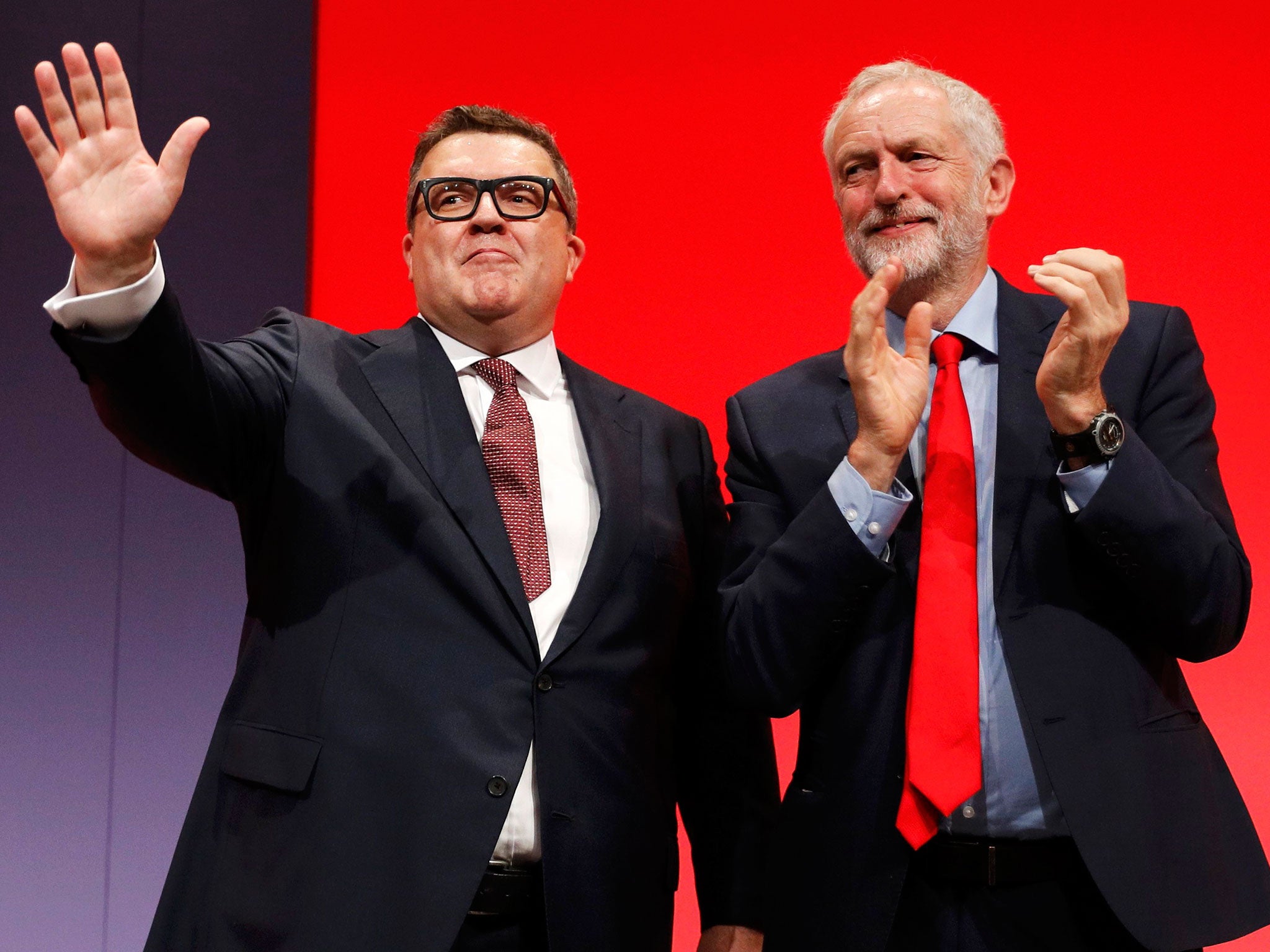Your guide to the next phase of Labour’s civil war
Jeremy Corbyn faces six alternative power centres in the Labour Party – his supporters face a huge task in trying to take over them all


Never mind the warm words about party unity in Liverpool this week: the civil war goes on and it will continue until one side has control over the whole party. Despite Jeremy Corbyn’s being confirmed as leader by a convincing margin on Saturday, his enemies still control large parts of the Labour machine. That means the leader cannot do everything his supporters want.
These are the six main alternative power centres in the party, with my explanation of the task Corbyn’s supporters face in trying to take control of them.
1. Parliamentary Labour Party
That Corbyn has the committed support of about 20 of Labour’s 232 MPs is his biggest problem. It is also the hardest for him to do anything about. So far his tactic has been to “reach out” to the soft middle of MPs to try to persuade them to join him on the grounds that they can’t beat him.
This involves the inducement of status in the shadow cabinet, combined with the threat of refusing to rule out deselecting them as Labour MPs. In his speech yesterday Corbyn praised his parliamentary colleagues who had stepped up to fill the gaps in the shadow cabinet and said pointedly: “They are our future.”
But Corbyn is reluctant to offer them any olive branches from the tree on his office balcony that would diminish his authority. He won’t move John McDonnell from the shadow chancellor post, which would be the biggest sign that he was genuinely interested in running a broad-based, balanced leadership team. And he is resisting the idea that Labour MPs should elect some or all of his shadow cabinet. Here are the key battle grounds within the PLP:
Shadow cabinet elections
When the party was in opposition, Labour MPs elected some of their own number to serve in the shadow cabinet, until the elections were abolished by Ed Miliband in 2011. In the last shadow cabinet election in 2010, MPs elected a list of 19 names: it was then up to the leader to allocate portfolios to them.
The shadow cabinet is important because, as with the real cabinet, leadership in the British system is collective. Although the leader has the authority of his or her position, and the power to propose, lead discussion and ultimately to sack shadow ministers, the party's day-to-day line in the Commons is supposed to be decided by the shadow cabinet, with a vote being taken if necessary.
Labour MPs have voted to restore shadow cabinet elections, but this has to be approved by the National Executive (see below).
The shadow shadow cabinet
There is nothing to stop Labour MPs electing a shadow cabinet anyway, but Corbyn wouldn’t have to pay any attention to it. There has been talk of the majority of Labour MPs setting themselves up as a rival grouping in the Commons. If most of the 172 who voted to express no confidence in Corbyn’s leadership in July joined it, they would be the official opposition. But that would be to split the party, and get the blame for it, with little evidence that there would be a grassroots party to support it outside Parliament. Oh, and it would require courage, leadership and organisation.
What they have done instead is to do what they usually do, which is to elect the chairs of backbench policy committees. These include Tristram Hunt, John Woodcock and Emma Reynolds. Because the party is divided, these chairs are sometimes described by journalists as the “shadow shadow cabinet”, and their views are likely to be given more prominence than usual.
The full list of chairs is here.
Deselections
Local Labour parties have the right to decide that they don’t want their MP any more, and that they want to choose a different candidate to fight the next election. As I explained yesterday, the rules make it difficult. The procedure has to be started by a trigger ballot, which can take place only when authorised by the National Executive, which means that they are unlikely to happen until after the new constituency boundaries are finalised in September 2018.
A trigger ballot is an odd form of democracy, in which all branches and organisations affiliated to a local party have an equal vote – in effect giving a lot of power to local trade unions.
But the politics make deselections even more difficult: they poison relationships in local parties, and provide damaging stories of disunity. An MP who feels threatened may resign, causing a by-election, in which they could stand as something like Real Labour or Democratic Labour against the official Labour candidate chosen by members of the local party, and might well win.
2. National Executive Committee
The NEC is the party’s ruling body, although in practice it has to share power with MPs, and the party’s annual conference (see below) has the final say over policy and the party’s rules. The NEC consists of delegates from parts of the party, including affiliated trade unions, and is currently quite evenly and unpredictably balanced between the forces of Corbyn and those against him.
The anti-Corbyn forces won two victories this week. First, they expanded the NEC to include non-Corbyn representatives from the Scottish and Welsh Labour parties. Second, they secured the election – by one vote – of Glenis Willmott, a non-Corbyn leader of the Labour Group in the European Parliament, as chair of the NEC for the next year. (The Labour Group in the European Parliament is a seventh centre of non-Corbyn power, although it will cease to exist in a bit more than two years’ time.)
Corbyn supporters have already won a clean sweep of the six NEC places that are directly elected by Labour members, so any advances have to be fought through the thickets of structures to nominate representatives of trade unions, MPs, socialist societies and local councillors.
The NEC is the main battle field because it has wide discretion over the rules – for leadership contests in particular – as the courts confirmed this year. And it can propose constitutional changes to annual conference. The next battle will be at an NEC “awayday” in November.
3. Deputy Leader
Tom Watson has his own mandate, and used it to some effect in his speech on Tuesday. Corbyn’s supporters thought it was malicious and divisive; Watson’s supporters – ironically including his former enemies who resented his part in Tony Blair’s downfall – cheered him loudly.
Corbyn’s supporters could try to challenge him. Len McCluskey, the leader of Unite the union, who didn’t get the unity memo either, said yesterday: “If Tom wants to try and refresh his mandate, it would be interesting to see what happens.”
But the rules require a challenger to be nominated by 51 Labour MPs and MEPs, which seems unlikely to happen. McCluskey managed to sound sinister and divisive without having the capacity to deliver on his threat.
4. Local government
Sadiq Khan, the Mayor of London, is the most powerful Labour politician in the country. He is able to put policy into practice and he is able to employ advisers and officials who are not Corbyn supporters. His speech at Labour conference was also an obvious challenge to Corbyn, with its repeated references to the importance of being in power.
Andy Burnham, Sion Simon and Steve Rotheram may soon be in charge of big metropolitan authorities in Manchester, the West Midlands and Greater Liverpool. Burnham’s ideological position is ambiguous and Rotheram was Corbyn’s parliamentary aide, but wait until they are in office.
Labour local councils generally are in the hands of the non-Corbyn forces: I cannot think of any council leader who is a Corbyn supporter.
5. National Policy Forum
Labour Party policy is formally decided by the NPF, currently chaired by Angela Eagle, a deliberately complicated and long-drawn-out series of meetings, mostly of trade union and local party representatives. It culminates in an all-night haggle, traditionally at Warwick University, some months before an election to decide the “programme” on which the party manifesto will be based.
6. Annual Conference
The NPF was created to muffle the absolute power of the Labour Party’s annual conference to decide policy. In practice, policy is decided by an interaction between the leadership and party institutions, as happened on Trident this week.
But annual conference is the ultimate arbiter of the party constitution, and so any rule changes for leadership elections would have to be voted on there. Corbyn supporters failed to organise to ensure that they had a clear majority among the delegates in Liverpool this year. Next year might be different, and there has been talk about changing the rules to make it harder to challenge the leader. However, such a change would probably not go through the current NEC. So it wouldn’t be until 2018 that any rule changes could be made, and that assumes that Corbyn gains firmer control of the NEC next year.
In other words: several years of what Corbyn yesterday called “trench warfare” ahead.
Join our commenting forum
Join thought-provoking conversations, follow other Independent readers and see their replies
Comments
Bookmark popover
Removed from bookmarks